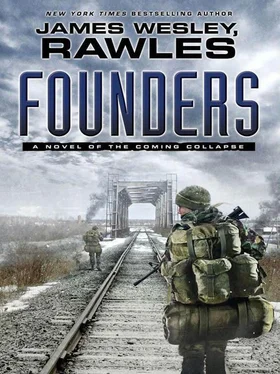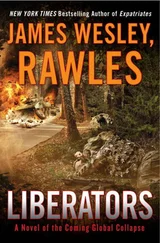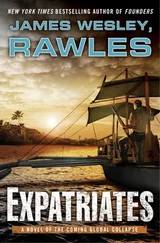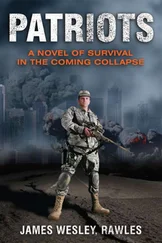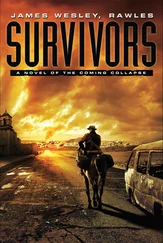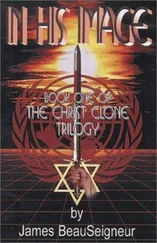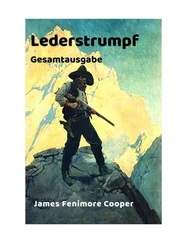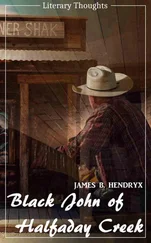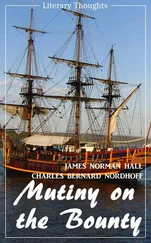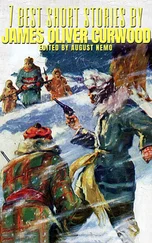James Rawles - Founders
Здесь есть возможность читать онлайн «James Rawles - Founders» весь текст электронной книги совершенно бесплатно (целиком полную версию без сокращений). В некоторых случаях можно слушать аудио, скачать через торрент в формате fb2 и присутствует краткое содержание. Город: New York, Год выпуска: 2012, ISBN: 2012, Издательство: Emily Bestler Books, Жанр: sf_postapocalyptic, на английском языке. Описание произведения, (предисловие) а так же отзывы посетителей доступны на портале библиотеки ЛибКат.
- Название:Founders
- Автор:
- Издательство:Emily Bestler Books
- Жанр:
- Год:2012
- Город:New York
- ISBN:978-1-4391-7282-7
- Рейтинг книги:5 / 5. Голосов: 1
-
Избранное:Добавить в избранное
- Отзывы:
-
Ваша оценка:
- 100
- 1
- 2
- 3
- 4
- 5
Founders: краткое содержание, описание и аннотация
Предлагаем к чтению аннотацию, описание, краткое содержание или предисловие (зависит от того, что написал сам автор книги «Founders»). Если вы не нашли необходимую информацию о книге — напишите в комментариях, мы постараемся отыскать её.
Founders — читать онлайн бесплатно полную книгу (весь текст) целиком
Ниже представлен текст книги, разбитый по страницам. Система сохранения места последней прочитанной страницы, позволяет с удобством читать онлайн бесплатно книгу «Founders», без необходимости каждый раз заново искать на чём Вы остановились. Поставьте закладку, и сможете в любой момент перейти на страницу, на которой закончили чтение.
Интервал:
Закладка:
The dry, rocky soil made digging difficult. Ignacio’s original plan had been to dig a hole five feet deep. But as the day warmed up and blisters began to form, he revised his plan to dig a trench just two feet deep. The gold and platinum coins as well as a large assortment of jewelry and gemstones had already been packed in eighteen U.S. military surplus .50 caliber ammo cans. The greatest value was in loose diamonds and diamond wedding rings. García’s wife had lost count at just over 300 stones, so she estimated that there were at least 350 diamonds. The cans were so heavy that they were difficult for a man to lift and carry.
Before placing the cans in the hole, Ignacio opened them and applied a coating of Vaseline to the rubber gaskets on their lids. After taking a few minutes to admire his treasure ( tesoro ), he resealed the cans. They laid the cans in the bottom of the trench, covered them with two thicknesses of trash bags, and then refilled the trench. They spent thirty minutes scattering the excess dirt and smoothing over the site to make it look undisturbed. Then they dragged some scrap metal they found near the tractor and placed it on top of the cache to serve both as a reminder of where the cache was located and to foil anyone who might someday use a metal detector.
He wrote down the precise GPS coordinates for both the tractor and the cache on two pieces of paper. He then trimmed them to the size of business cards and laminated them on both sides with clear packing tape. He had his wife sew one of these into the lining of her fur coat, and one into his leather belt.
In June, García’s gang drove into Colorado, following their time-proven hit-and-run tactics. They gathered trucks and vans to replace some of the vehicles lost in the Humboldt and Dewey, Arizona, fiasco.
In each town they hit, they began to hear more and more about the ProvGov. Generally called the Federals—or as García’s men termed them, los federales —they were a great concern to García and his lieutenants. They were told that Fort Carson was the headquarters for the UNPROFOR in Colorado.
One of García’s men approached him and said, “These federales , they’re going to squash us like a bug.”
García shook his head. “Not if we become security contractors. As contractors, we’ll just have to give up a little piece of what we take, but we’ll have legitimacy. Under the martial law, it will all be official. We’ll be employees of the ProvGov.”
So they dubbed themselves Force Two Associates, or simply F2. Carlos, who had been a graffiti tagger before he’d joined La Fuerza, cut a handsome sixteen-inch-tall “F2” stencil for painting the doors, hoods, and tailgates of their trucks. They used glossy black spray paint. Some of the camp followers carefully embroidered the F2 logo on some stolen tan baseball caps to match.
Negotiating with the regional administrator at Fort Carson went rapidly. García quickly hammered out a mutually acceptable charter. The UNPROFOR’s cut was 20 percent of all loot. The regional administrator took a further personal commission of 2 percent, although that was not mentioned in the charter contract. But he made it clear that if he didn’t get his cut, in gold, he would leave García twisting in the wind.
Fort Knox, Kentucky
September, the Third Year
To Andy, joining the New Army seemed simultaneously familiar and strange. For example, when he drew his issue of field gear, it was still called “TA-50” gear, but it was an odd assortment of field gear that included a set of U.S. interceptor body armor (IBA), a German sleeping bag, a Dutch tent, Belgian waterproof over-boots and parka, a French backpack, and a battered Russian mess kit. At the same time, he was handed a chit for an “Article 4 Exemption” Hardigg locker. This, he was told, could be picked up at the Army Community Service (ACS) and Army Emergency Relief (AER) Outreach Office on Binter Street. The ACS office was not far from the Commissary and Exchange stores. It seemed strange to him that the ACS charity would issue a piece of military equipment.
Andy drove to the ACS/AER office on his lunch hour. As he entered the building, he walked by two contract civilian security guards who were armed with laser-mounted M4s. The men were lounging in overstuffed chairs in the foyer. By their clothes and mannerisms, they looked like XE Corporation toughs or at least XE wannabes.
Inside the building, Andy expected to see a utilitarian office. But he was stunned to see that the office was overfurnished with ornate antique furniture. Every bit of wall space was lined with fancy chairs, armoires, china cabinets, and marble-top tables. He handed the chit to a plump secretary who wore too much eye makeup. As she rose from her chair, Andy observed that she was armed with a wakazashi Japanese short sword, carried in a sashlike obi belt. She escorted him to a room with a pile of empty Hardigg lockers and said matter-of-factly, “Take one. You’ll have to provide your own lock and chain.”
Andy shouldered one of the lockers and carried it out to his pickup. When he opened the locker to examine it, he found a silkscreened sign the size of a bumper sticker lacquered inside the lid. It read:
Inspection Exempt Items, Per Art. 4, ProvGov-UNPROFOR Agreement. Please give generouslyto A.C.S./A.E.R. When this locker is too full to hold any more, then it’s time to give. Thank You.—Ft. Knox A.C.S.
When he got back to his quarters that evening, Andy discussed the locker with Kaylee. He said, “I feel like I’ve been transported into an alternate universe. The AER office used to be just a place for penniless wives of junior NCOs to get the bare-bones necessities of running a household, like diapers and dishes, and stew pots. But now the place looks like something out of an antique furniture auction catalogue. It’s bizarre. Do you remember when we borrowed my dad’s set of the old Star Trek television series on DVD? There was that parallel universe episode where Spock had a beard?”
Kaylee nodded and said, “Yeah, it was called Mirror, Mirror. ”
“Yep, that’s the one. Well, I haven’t met a bearded Mr. Spock yet, but today I met Uhura with a dagger. The world has been turned inside out. Since when is a charitable organization given control of excess loot?”
26. Trampling Out the Vintage
“Freedom is never more than one generation away from extinction. We didn’t pass it to our children in the bloodstream. It must be fought for, protected, and handed on for them to do the same, or one day we will spend our sunset years telling our children and our children’s children what it was once like in the United Stated where men were free.”
—President Ronald Wilson ReaganFort Knox, Kentucky
January, the Fourth Year
As the Resistance continued to gain ground, the ProvGov tried to sound upbeat in their propaganda broadcasts. The UN’s Continental Region 6, which included the territory that had been the United States, Mexico, and Canada, was in a losing war with the guerrillas. There was resistance growing throughout the region. The resistance ranged from passive protest to sabotage and overt military action. The UN was steadily losing control of Region 6.
It was becoming clear that resistance was the strongest, the best organized, and the most successful in rural areas. Unable to wipe out the elusive guerrillas, the UN administration and their quislings began to concentrate on eliminating the guerrillas’ food supplies.
In areas where resistance was rampant, “temporary detainment facilities” were constructed to house anyone thought to be politically unreliable. Special emphasis was placed on rounding up suspect farmers or ranchers, or anyone remotely connected with food distribution businesses. When farmers were put into custody, their crops were confiscated, plowed under, or burned. The authorities carefully monitored bulk food stocks.
Читать дальшеИнтервал:
Закладка:
Похожие книги на «Founders»
Представляем Вашему вниманию похожие книги на «Founders» списком для выбора. Мы отобрали схожую по названию и смыслу литературу в надежде предоставить читателям больше вариантов отыскать новые, интересные, ещё непрочитанные произведения.
Обсуждение, отзывы о книге «Founders» и просто собственные мнения читателей. Оставьте ваши комментарии, напишите, что Вы думаете о произведении, его смысле или главных героях. Укажите что конкретно понравилось, а что нет, и почему Вы так считаете.
